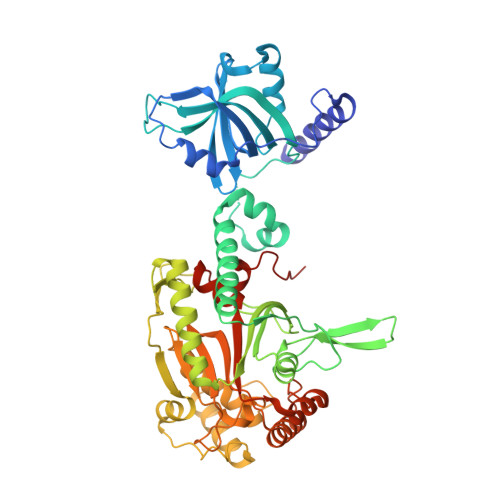Human lysyl-tRNA synthetase evolves a dynamic structure that can be stabilized by forming complex.
Wu, S., Zheng, L., Hei, Z., Zhou, J.B., Li, G., Li, P., Wang, J., Ali, H., Zhou, X.L., Wang, J., Fang, P.(2022) Cell Mol Life Sci 79: 128-128
- PubMed: 35133502
- DOI: https://doi.org/10.1007/s00018-022-04158-9
- Primary Citation of Related Structures:
7F6W - PubMed Abstract:
The evolutionary necessity of aminoacyl-tRNA synthetases being associated into complex is unknown. Human lysyl-tRNA synthetase (LysRS) is one component of the multi-tRNA synthetase complex (MSC), which is not only critical for protein translation but also involved in multiple cellular pathways such as immune response, cell migration, etc. Here, combined with crystallography, CRISPR/Cas9-based genome editing, biochemistry, and cell biology analyses, we show that the structures of LysRSs from metazoan are more dynamic than those from single-celled organisms. Without the presence of MSC scaffold proteins, such as aminoacyl-tRNA synthetase complex-interacting multifunctional protein 2 (AIMP2), human LysRS is free from the MSC. The interaction with AIMP2 stabilizes the closed conformation of LysRS, thereby protects the essential aminoacylation activity under stressed conditions. Deleting AIMP2 from the human embryonic kidney 293 cells leads to retardation in cell growth in nutrient deficient mediums. Together, these results suggest that the evolutionary emergence of the MSC in metazoan might be to protect the aminoacyl-tRNA synthetase components from being modified or recruited for use in other cellular pathways.
Organizational Affiliation:
State Key Laboratory of Bioorganic and Natural Products Chemistry, Center for Excellence in Molecular Synthesis, Shanghai Institute of Organic Chemistry, University of Chinese Academy of Sciences, Chinese Academy of Sciences, 345 Lingling Road, Shanghai, 200032, China.
















